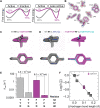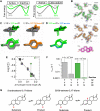Ensemble-function relationships to dissect mechanisms of enzyme catalysis
- PMID: 36240280
- PMCID: PMC9565801
- DOI: 10.1126/sciadv.abn7738
Ensemble-function relationships to dissect mechanisms of enzyme catalysis
Abstract
Decades of structure-function studies have established our current extensive understanding of enzymes. However, traditional structural models are snapshots of broader conformational ensembles of interchanging states. We demonstrate the need for conformational ensembles to understand function, using the enzyme ketosteroid isomerase (KSI) as an example. Comparison of prior KSI cryogenic x-ray structures suggested deleterious mutational effects from a misaligned oxyanion hole catalytic residue. However, ensemble information from room-temperature x-ray crystallography, combined with functional studies, excluded this model. Ensemble-function analyses can deconvolute effects from altering the probability of occupying a state (P-effects) and changing the reactivity of each state (k-effects); our ensemble-function analyses revealed functional effects arising from weakened oxyanion hole hydrogen bonding and substrate repositioning within the active site. Ensemble-function studies will have an integral role in understanding enzymes and in meeting the future goals of a predictive understanding of enzyme catalysis and engineering new enzymes.
Figures






Similar articles
-
Assessment of enzyme active site positioning and tests of catalytic mechanisms through X-ray-derived conformational ensembles.Proc Natl Acad Sci U S A. 2020 Dec 29;117(52):33204-33215. doi: 10.1073/pnas.2011350117. Epub 2020 Dec 21. Proc Natl Acad Sci U S A. 2020. PMID: 33376217 Free PMC article.
-
Water in the active site of ketosteroid isomerase.Biochemistry. 2011 Aug 9;50(31):6689-700. doi: 10.1021/bi200703y. Epub 2011 Jul 13. Biochemistry. 2011. PMID: 21710970 Free PMC article.
-
Evaluation of the Catalytic Contribution from a Positioned General Base in Ketosteroid Isomerase.J Am Chem Soc. 2016 Aug 10;138(31):9902-9. doi: 10.1021/jacs.6b04796. Epub 2016 Jul 27. J Am Chem Soc. 2016. PMID: 27410422
-
Structure and enzymology of Delta5-3-ketosteroid isomerase.Curr Opin Struct Biol. 2001 Dec;11(6):674-8. doi: 10.1016/s0959-440x(01)00268-8. Curr Opin Struct Biol. 2001. PMID: 11751047 Review.
-
Enzymatic mechanisms for catalysis of enolization: ketosteroid isomerase.Bioorg Chem. 2004 Oct;32(5):341-53. doi: 10.1016/j.bioorg.2004.06.005. Bioorg Chem. 2004. PMID: 15381400 Review.
Cited by
-
Perspectives on Computational Enzyme Modeling: From Mechanisms to Design and Drug Development.ACS Omega. 2024 Feb 8;9(7):7393-7412. doi: 10.1021/acsomega.3c09084. eCollection 2024 Feb 20. ACS Omega. 2024. PMID: 38405524 Free PMC article. Review.
-
Interplay of structural preorganization and conformational sampling in UDP-glucuronic acid 4-epimerase catalysis.Nat Commun. 2024 May 8;15(1):3897. doi: 10.1038/s41467-024-48281-6. Nat Commun. 2024. PMID: 38719841 Free PMC article.
-
Potent GST Ketosteroid Isomerase Activity Relevant to Ecdysteroidogenesis in the Malaria Vector Anopheles gambiae.Biomolecules. 2023 Jun 11;13(6):976. doi: 10.3390/biom13060976. Biomolecules. 2023. PMID: 37371556 Free PMC article.
-
Cell phenotypes can be predicted from propensities of protein conformations.Curr Opin Struct Biol. 2023 Dec;83:102722. doi: 10.1016/j.sbi.2023.102722. Epub 2023 Oct 21. Curr Opin Struct Biol. 2023. PMID: 37871498 Free PMC article. Review.
-
FLEXR-MSA: electron-density map comparisons of sequence-diverse structures.IUCrJ. 2025 Mar 1;12(Pt 2):245-254. doi: 10.1107/S2052252525001332. IUCrJ. 2025. PMID: 40014007 Free PMC article.
References
-
- J. M. Berg, J. L. Tymoczko, L. Stryer, J. M. Berg, J. L. Tymoczko, L. Stryer, Biochemistry (W H Freeman, ed. 5, 2002).
-
- A. Fersht, Enzyme Structure and Mechanism (W.H. Freeman, 1985).
-
- Kim D.-H., Jang D. S., Nam G. H., Choi G., Kim J.-S., Ha N.-C., Kim M.-S., Oh B.-H., Choi K. Y., Contribution of the hydrogen-bond network involving a tyrosine triad in the active site to the structure and function of a highly proficient ketosteroid isomerase from Pseudomonas putida biotype B. Biochemistry 39, 4581–4589 (2000). - PubMed
-
- Lawson S. L., Wakarchuk W. W., Withers S. G., Effects of both shortening and lengthening the active site nucleophile of bacillus circulans xylanase on catalytic activity. Biochemistry 35, 10110–10118 (1996). - PubMed

